THE TRAMWAYS OF VENEZUELA (original) (raw)
The Tramways of CARÚPANO
Venezuela
BY Allen Morrison
Carúpano is a small port on the Caribbean coast about 350 km east of La Guaira. It is the second-largest city in Sucre state, which lies opposite the former British colony of Trinidad [see area map]. Sucre's capital and largest city is Cumaná. Carúpano is near the spot where Christopher Columbus first set foot in South America and was the place where the first submarine cable reached South America from Europe. It was the destination of many French-speaking immigrants from Corsica in the 19th century. Population was about 12,000 in 1900, was about 25,000 in 1930, and is about 125,000 today.
Like many Venezuelan cities, Carúpano never had a rail connection with the rest of Venezuela. But it had a tramway on its main street for about 50 years. The 1883 Memoria de Obras Públicas [click to see] describes the franchise awarded in 1882 to José Gabriel Núñez Romberg to build "tranvías o ferrocarriles" in Carúpano and Maturín in Bermúdez state (renamed Sucre in 1909). In La Construcción de la Modernidad: El Caso de Carúpano, published in 1990 [see BIBLIOGRAPHY], author Rafael Cartay states that Núñez Romberg founded the Compañía Anónima de Tranvías de Carúpano in 1883. A U.S. Consular Report of 1885 says that the "tramway plant" came from the United States and in La Venezuela del Viejo Ferrocarril, published in 1990, author Luis Cordero Velásquez claims that operation began in 1884.
C.A. de Tranvías de Carúpano went bankrupt in 1891 and was sold at auction to a Corsican named Dominique Pieri. The latter's tramway prospered for a while, but was plagued by local resentment of foreign enterprise and a dispute arose when Pieri built a branch without municipal permission. The city removed a section of his rails and revolutionaries destroyed most of his structures, vehicles and animals in 1902. With the help of the French consulate, Pieri sought and won compensation from the Venezuelan government, but it is not clear whether he reopened his tram line. [The Pieri affair is described on pp. 185-210 of the Report of French-Venezuelan Mixed Claims Commission of 1902.]
The Memoria de Obras Públicas of 1917 [see BIBLIOGRAPHY] notes a contract for tramway construction awarded to a Venezuelan, Julio Bescanza, in 1907. Bescanza sold his franchise in 1910 to the Cumaná & Carúpano Pier & Tramway Company, which had been organized in New Jersey, USA, for the purpose of developing electricity, transportation and port facilities in Sucre state. C&CP&T began construction of an electric tram line in Carúpano and ordered two 4-wheel open cars from J. G. Brill Co. in Philadelphia on 6 May 1915. This photograph of car #1 was taken at the factory before it was shipped to Venezuela [col. AM]:
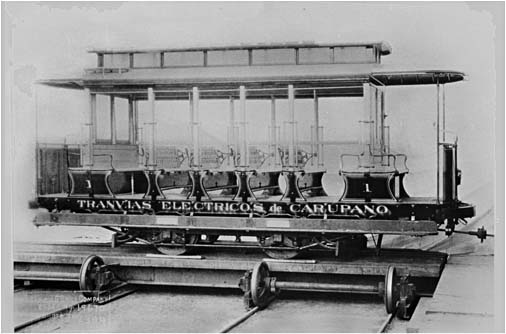
The two trams arrived at the port in December 1915 and Tranvías Eléctricos de Carúpano began carrying passengers on 9 January 1916. The photograph below was taken shortly after the inauguration. The passing place was probably at Plaza Colón in the town center [see city map]. Track gauge of the Carúpano tramway was 42 in/1067 mm, the same used by the tramways in Caracas and Valencia [Memoria de Obras Públicas of 1916, v. 2]:
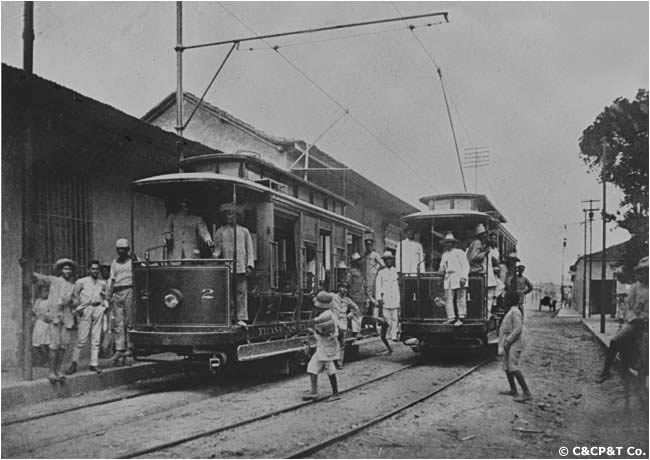
As shown on the map, the line ran the entire length of Av. Independencia, the main thoroughfare, then along the harbor to the port. Total distance, including branches, was 2.4 km. This was the shortest electric railway in Venezuela and one of the shortest on the continent. According to C&CP&T documents, the tram depot was the building in the center of the photograph below – number "8" on the map. The picture was taken in 1916, before the connecting track had been laid [C&CP&T]:
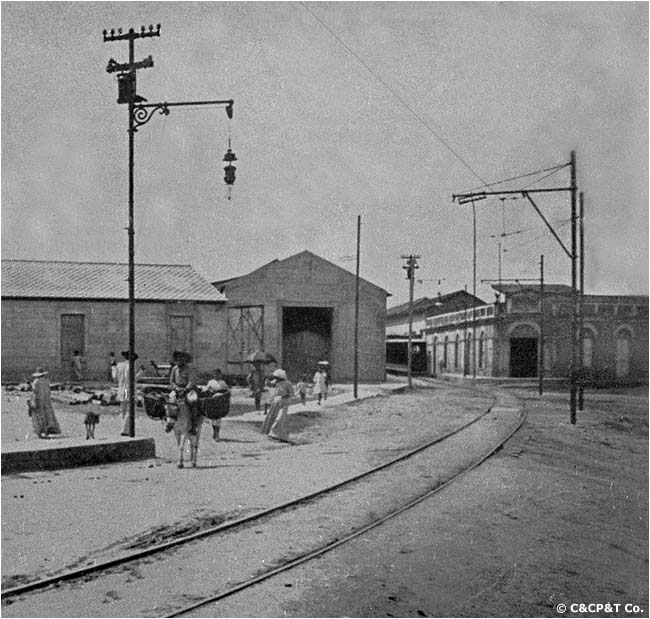
C&CP&T did not own locomotives, so in addition to passenger service the trams pulled trailers with cargo around the docks and to merchants in the town [see map]. Note upper and lower lines here, both with overhead wires. The lower track continued onto a pier [C&CP&T]:
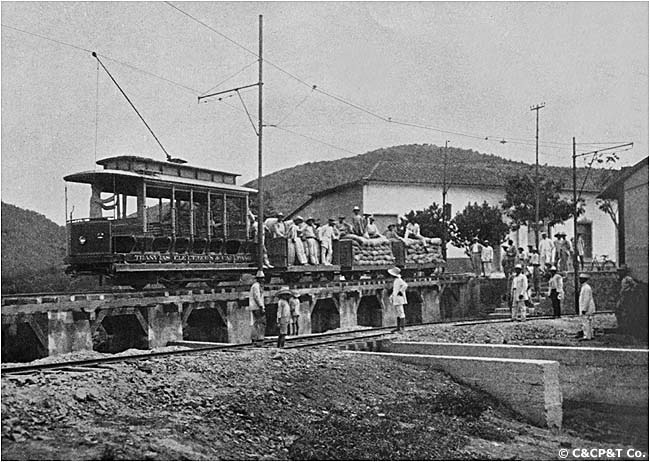
Tram 2 in front of Hotel Victoria – "7" on the map. The photographer is facing east. The man on the right is standing on a bridge over a creek [C&CP&T]:
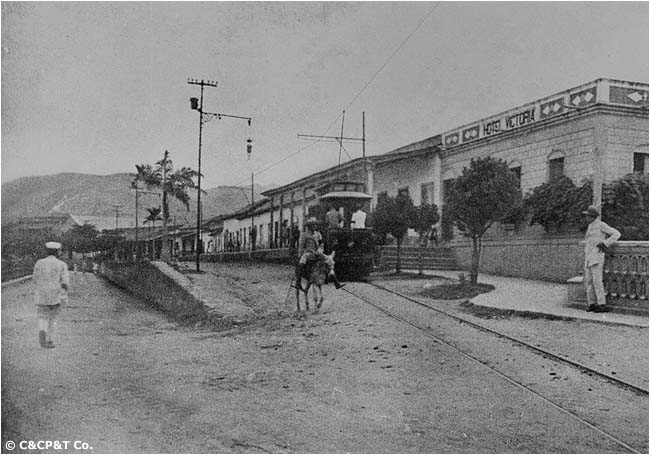
The postcard view below, made in the 1920s, shows an electric tram at the same spot as in the picture above. Note the bridge over the creek and the lower road along the shore. The large buildings extreme left are the Aduana (Customs House) and the electric power plant [see map] [col. AM]:
Here is the complete postcard view, from which the scene above was excised [col. AM]:
The later history of the Carúpano tramway is unknown. The Venezuelan government's Anuario Estadístico of 1937 reports tramway operations only in Caracas and Valencia, so the Carúpano line apparently disappeared before that year. The city was heavily damaged by a hurricane on 28 June 1933 and the tramway may have closed at that time. But the rails remained. A 1939 street map of Carúpano [see BIBLIOGRAPHY] still showed and identified the "RIELES DEL TRANVÍA VIEJO". Happy memories no doubt lasted much longer.
BIBLIOGRAPHY
(in order of publication)
Venezuela. Ministerio de Obras Públicas. Memorias of 1883, 1916 and 1917. Caracas, 1883-. "Tranvías en el Estado Bermúdez" on p. 230 of the 1883 edition notes the 1882 tramway contract. "Informe de The Cumaná & Carúpano Pier & Tramway Company" on pp. 252-262 in vol. 2 of the 1916 edition describes the new harbor and tramway facilities in detail; photographs on pp. 253-257. Documents 400-403 on pp. 402-405 in vol. 2 of the 1917 edition provide further information about the power plant, tram cars and tram depot.
United States. Department of State. Bureau of Manufactures. Monthly Consular and Trade Reports, No. 49, January 1885 [pdf download available online]. The "Affairs at Carúpano, Venezuela" chapter on p. 401 records the tramway installation.
Cumaná & Carúpano Pier & Tramway Company. Sus Obras y Concesiones. Caracas, 1916. Description of the company and its installations in Venezuela. Source of the street map and four of the illustrations on this page. (Some of the pictures were also reproduced in the 1916 Memoria of Venezuela's Ministerio de Obras Públicas; see above.)
United States. Department of Commerce. Bureau of Foreign & Domestic Commerce. Special Agents Series no. 212. Washington, 1922. The chapter entitled "Venezuela: A Commercial and Industrial Handbook" sketches the development of the C&CP&T, including the Carúpano tramway, on pp. 159, 161 and 163.
Venezuela. Ministerio de Fomento. Dirección General de Estadística. Anuario Estadístico, 1937. The four "Cuadros Demostrativos del Movimiento Tranviario Habido en el País Durante el Año 1937" report data for Caracas and Valencia, but say nothing of other cities.
Venezuela. Ministerio de Obras Públicas. Informe Sobre las Obras Portuarias de Carúpano. Facilidades Existentes y Propuestas para el Puerto de Carúpano. Caracas, 1939. Map of harbor still shows "RIELES DEL TRANVÍA VIEJO" on city streets.
Rafael Cartay [Angulo]. La Construcción de la Modernidad: El Caso de Carúpano. Mérida, 1990 [available online]. Foundation of the C.A. de Tranvías de Carúpano by José Gabriel Núñez Rombarg [sic], p. 23.
Luis Cordero Velásquez. La Venezuela del Viejo Ferrocarril. Caracas, 1990. Chapter XXVII entitled "Los Lares del Tranvía Venezolano" notes on p. 228 that the Carúpano tramway opened in 1884.
See The Tramways of Macuto, La Guaira & Maiquetía
See The Trolleybuses of Mérida
See my index of
ELECTRIC TRANSPORT IN LATIN AMERICA
If you have comments, criticism or suggestions,
please e-mail me! Leo y escribo español.
This site was placed online on
15 November 2007
Copyright © 2007-2107 Allen Morrison ALL RIGHTS RESERVED TODOS LOS DERECHOS RESERVADOS